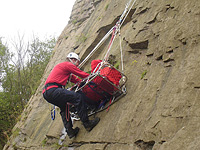
Rugged terrain and unreliable communication can lead to longer emergency response times in the backcountry (photo by Kinder Alan on Flickr.com)
In August of 2008, rescue crews evacuated hundreds of campers from the Grand Canyon floor as flash flooding breached the nearby Redlands Dam, south of Supai. In March, a man camping in New Mexico’s Sacramento Mountains fell 80 feet, while hiking with friends. In the Fall of 2007, more than a dozen campers were rescued from a runaway brushfire on Hawaii’s Big Island.
Camping emergencies are not usually so extreme, but anytime we venture into the backcountry we need to realize that we are now largely on our own. Emergency response times in the backcountry can be much longer, because smaller emergency crews are responsible for much larger areas than their city counterparts are.
We have experienced our own camping emergency when our (then) two-year-old son fell against the campfire ring, burning both of his forearms. Fortunately, we had Ziplocâ„¢ bags and ice to treat the burns, as well as baby Tylenolâ„¢ for the pain. Having those items available was more blind-luck than it was preparation, though, so this was a wake-up call that we needed to be better prepared for backcountry emergencies.
Natural Disasters
The most common natural disasters that you are ever likely to experience in the backcountry are fires and floods. Depending on your location, though, earthquakes (one of our nation’s largest earthquakes occurred in Yellowstone National Park, in 1959) and tornadoes are potential risks.
The key attribute of most natural disasters is that they occur without warning and affect large areas. This means that campers caught in a natural disaster may find themselves either cut-off for a period of time, or having to quickly move to safer ground, often times leaving gear and vehicles behind.
Preparing for such a disaster involves putting together a “fly away kit,†a small bag containing food, water, and medical items that could sustain you and your family for a period of 24 to 48 hours. We have to assume that in the event of an emergency, there will be no time for packing-up the tent and the rest of the camping gear.
Injuries
If preparing for natural disasters seems a bit neurotic (guilty – it’s a Paratrooper thing), being able to deal with minor medical emergencies in the backcountry is just good common sense. The most common medical issues that you might experience are:
- Sprained ankles
- Scrapes and cuts
- Allergic reactions (poison oak/ivy, insect stings and bites)
- Burns
- Intestinal issues / food poisoning
For more information on assembling a first aid kit for your family, be sure to read my December article on the subject, including Adam Shake’s very good comment.
Family camping is a great way to teach confidence and preparation to our children, who otherwise are taught to rely on others to handle emergencies, for them. This is one of the tenets of Scouting, and one of the reasons that Scouting is such a great organization for our kids. Confidence begins at home, though, and when our children see us handling emergencies calmly and effectively it has a lasting, positive, impact on their development.
See also…

Thanks for any other wonderful post. Where else may just anybody get that type of information in such a perfect manner of writing? I have a presentation subsequent week, and I’m on the search for such information.
The most rescues in Virginia State Parks are related to extreme weather conditions and the AT/Mount Rogers NRA/Grayson Highlands State Park area. The weather in the mountains is so much more extreme than the lower surrounding areas that folks come unprepared. We have even had to rescue scout groups!
Nancy Heltman’s last blog post..The Crewe Astronomy Club